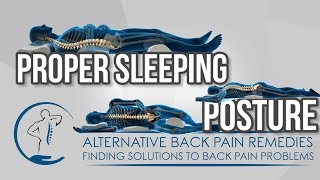Wednesday, 24 December, 2025г.
















Где искать: по сайтам Запорожской области, статьи, видео ролики
пример: покупка автомобиля в Запорожье
Worst and Best Sleeping Positions for Spine
Poor sleeping position coupled with poor posture are the leading causes of back pains and joint pains. This is because poor or bad sleeping position put much pressure at a particular point on the spine hence resulting in pains at that particular point.
The healthiest sleeping positions are those that allow the alignment of the head, neck and abdomen. This style of sleeping allows the spine to follow its natural curves and dose not put much pressure on it at any one particular spot, rather it distributes this pressure equally and the body is balanced.
In this video, we’ll review some of the most popular sleeping position, see how they impact your health, and provide you with a few tips on how to get the best out of each sleeping position.
Sleeping on the back
In a statistical study, eight percent of people were found using this sleeping position on a regular basis.
Surprisingly, back sleeping is one of the best sleeping positions. This is because back sleeping gives the body a neutral position. When you're lying on your back with your face facing the ceiling, your head, neck and abdomen are in a neutral position and there’s no extra pressure on the spine curvature at any of those points.
Lying on the back also helps control acid reflux. Our stomach contains a lot of acids. When we are in an awkward sleeping position some of these acidic contents can slowly seep towards the esophagus and cause mild to severe pains depending on the quantity.
When we lie in a neutral position such as the back, the stomach is also in a neutral position and there will be no upper movement of its acidic contents towards the esophagus.
Sleeping on your back can however, make breathing difficult. Most times when we lie on our back, the tongue tends to roll backward, blocking the breathing tube. As such back sleeping is not recommended for those suffering sleep apnea as it may escalate the condition.
Back sleepers require a medium firm mattress. Too soft a mattress allows the spine to sink too deep into the mattress.
While lying on your back, it is also recommended that you put a pillow beneath your knees. This way your body will be in the best position.
Sleeping on your side
Roughly fifteen percent of adult sleep on their side. The side sleeping position is one of the most common types of sleeping position. It is highly recommended for those suffering sleep apnea as it keeps the air tubes wide open during sleep.
If you're also worried about snoring during your sleep, you may want to give the side sleeping position a try. By keeping the tongue out of the air tract during sleep, the side sleeping position solves the snoring noise or at least reduces its intensity.
Side sleeping however causes the face to become wrinkle. This is often because the face is pressed really hard against the pillow during the hour of sleep. Also, young women may want to avoid the side sleeping position as it causes the breast to lean sideways and as such may sag quickly.
If you plan sleeping on your side, it’s recommended you get a soft to medium firm mattress that allows your shoulders and hips sink. This way your spine will be put in a neutral position.
The fetal sleeping position
Roughly forty-five percent of adults sleep in the fetal position, making it the most popular sleeping position.
The fetal sleeping position got its name from the posture of the fetus while still in the womb. The fetus sleeping position is much like the side sleeping position. Sleepers sleep on their side just as they do in the side sleeping position but instead of keeping the legs and torso straight, the legs are bent at the knees and as such curves outward and the torso is hunched.
The fetal sleeping position is particularly recommended for pregnant women as it helps with blood circulation to all parts of the body as well as the fetus during a night rest. This is because unlike the rest sleeping position, the fetal sleeping position prevents the uterus from pressing the liver when you lie on your left side.
Like the side sleeping position, the fetal sleeping position is effective at keeping the breathing tube open and as such is highly recommended for those suffering sleep apnea or having snoring problems.
Sleeping on your stomach
Aside easing snoring, sleeping on the stomach has no other benefits. In fact, the stomach sleeping position is rated as one of the worst sleeping position there is.
For one, it’s quite difficult to maintain the neutral position of the spine while lying on your stomach. This of course translates to back, knee and joint pains after waking up.
Its best you avoid this sleeping position but if you must then it’s best you lay on your stomach with your head propped up with a pillow and face down instead of being turned sideways as that will block your upper air tracts and make breathing difficult.
Stomach sleepers should go for medium to firm mattresses that keep the spine in a neutral position.
Background Music: Youtube Audio Library
Теги:
sleeping positions healthy sleeping positions wrong sleeping positions spine Sleeping on the back Sleeping on your side The fetal sleeping position Sleeping on stomach back pain joint pain neck pain spine pain unhealthy sleeping position sleeping style pillow mattress soft soft pillow soft mattress posture sleeping posture
Похожие видео
Мой аккаунт


 У вашего броузера проблема в совместимости с HTML5
У вашего броузера проблема в совместимости с HTML5


